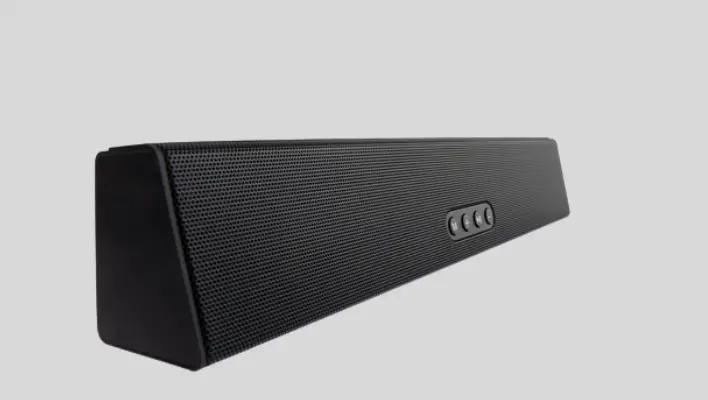Soundbars are a popular option for home theater systems due to their space-saving design. They provide a great surround sound experience and are typically easier to install than traditional multi-speaker setups.
However, if you want to take your sound system to the next level, you may want to consider adding a subwoofer.
Why add a subwoofer to a soundbar?
Subwoofers can supplement a sound system’s main speakers, reproducing low-frequency sounds that cannot be reproduced as accurately by the main speakers.
Connecting a subwoofer to a soundbar is a great way to improve the sound quality of your home audio system and ensure that you get the full range of sound. By reproducing low frequencies, it provides a powerful bass sound that can be felt as much as heard.
Connecting a subwoofer to your soundbar will not only make your audio system sound better, but it will also make it sound fuller and more immersive.
Furthermore, hooking it up also expands your listening environment; enabling users to better appreciate spacious and enveloping virtual surround sound capabilities which cannot be achieved with the single component alone.
What’s more, combining a soundbar and subwoofer dramatically increases available wattage and total acoustic power output due to sound diffusion across multiple-channels. The increased wattage reduces distortion while enhancing audio clarity compared to standard systems.
Finally, because many of these products have wide coverage angles capable of providing many listeners with immersive audio, connecting a separate subwoofer helps address any dead spots or zones that may have gone unpowered by soundbar alone.
Can you connect any subwoofer to a soundbar?
The short answer is no. Not all subwoofers are compatible with all soundbars. It is important to make sure that your subwoofer and soundbar are compatible before attempting to connect them.
More often than not, standalone subwoofers and soundbars are not compatible. Generally, only when both the soundbar and the subwoofer are sold together or are built to work together, can the two be connected.
Soundbars are designed to work exclusively with the manufacturer’s own brand of subwoofers. This means that if you have a Bose soundbar, you will need to purchase a Bose-compatible subwoofer, and if you own a Sonos soundbar, you will need to buy the Sonos subwoofer. With any other soundbar, it is unlikely that you will be able to attach a subwoofer.
Once you’ve determined that your devices are compatible, it’s time to learn how to connect subwoofer to soundbar.

Steps to connect subwoofer to soundbar
Step 1: Determine Your Connector Type
The first step in connecting your subwoofer to a soundbar is to determine the type of connector you’ll need. Most soundbars are designed to use either an optical or coaxial connection.
Optical connections are usually preferred for soundbars, since they provide higher sound quality and less interference. If your soundbar only has an optical connection, you’ll need to use an optical cable to connect your subwoofer.
If your soundbar has both an optical and coaxial connection, you’ll need to decide which one you want to use. Generally, it’s best to use the optical connection if your soundbar supports it, as it will provide better sound quality.
Step 2. Identify the audio inputs and outputs on your soundbar.
The soundbar will typically have an audio input and an audio output. The audio input is where you will connect the subwoofer, while the audio output is where you will connect the main speakers.
Step 3: Connect the Subwoofer to Soundbar
The subwoofer will have both an audio input and an audio output. The audio input will be connected to the soundbar’s audio output, while the audio output will be connected to an amplifier or receiver.
If you’re using an optical connection, you’ll need to connect the optical cable from the soundbar to the subwoofer. If you’re using a coaxial connection, you’ll need to connect the coaxial cable from the soundbar to the subwoofer.
Once you’ve connected the cables, you’ll need to turn on the subwoofer and make sure it’s connected to the same power source as the soundbar.

Step 4: Adjust the Subwoofer Settings
Once the connection is done and dusted, you’ll need to adjust the settings on the subwoofer so that it’s in sync with the soundbar. You’ll want to adjust the volume and crossover frequency settings on the subwoofer to match the soundbar (explained in more detail below). This will ensure that the sound coming from the subwoofer and the soundbar are in sync.
The next and final step will be to test the connection to make sure it’s working properly. To do this, play some music or a movie on the soundbar and listen for the bass coming from the subwoofer. If you can hear the bass, then the connection is working properly. In case you can’t hear the bass, check all the connections again to make sure everything is connected properly. Also, make sure that the subwoofer is powered on, and the volume settings are correct.
Now is the time to adjust the settings on the subwoofer. This includes adjusting the volume, crossover frequency, and phase settings. If you are not sure how the crossover frequency is adjusted and phase settings done, here is how you do it:
- To adjust the crossover frequency, you will need to use the subwoofer’s “crossover” knob. This knob is typically located on the back of the subwoofer. Turn the knob to the desired frequency and then test the sound again.
- To adjust the phase setting, you will need to use the subwoofer’s “phase switch”. This switch is also located on the back of the subwoofer. Flip the switch to the desired setting until you achieve the desired effect.

Wrapping it All Up
That’s all there is to it! Connecting a subwoofer to a soundbar is a relatively simple process and can really take your home theater system to the next level. Just make sure that your devices are compatible, connect the two, and configure the subwoofer. With a few simple steps, you’ll be enjoying deep, powerful bass in no time!
